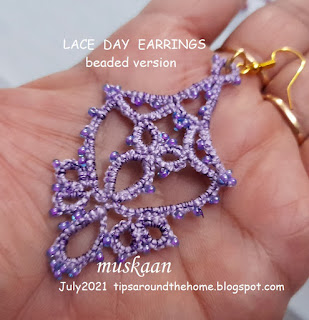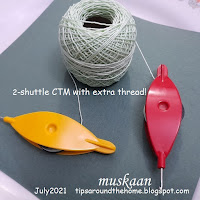Pin It now!
This is the first time I have posted a pattern elsewhere and not in my blog first. But it was crazy busy this weekend and I was simply too knackered to write out a proper post and share my notes, despite having uploaded a few pics yesterday morning.
So, without much ado, here's the Lace Day earring/pendant pattern - click to download diagram-only pdf. Eventually I will write out the pattern and add it to this, including a pic of the beaded model.
It all started when I thought of making a corner for
Frau Endrucks' pattern #17 by extracting one of the lovely motifs from it. Here you see it attached to the 2 sides in order to estimate that it would work. After snipping it off and turning it around, it looked lovely as a possible earring motif!
Found out it was International Lace Day on the 11th of July and I registered with a Facebook group and decided to quickly tat and create the pattern to share. The above 2-coloured model is worked in Lizbeth size 20.
TIP : Pattern starts with a chain. In order to avoid too many tail ends at the beginning and also to position the autumn leaves colour for the top ring, I used False CTM! Pull out enough length of thread from the shuttle (Sh2 in this case), work the first chain, and add the 2nd colour in that ring which I worked as a SCMR in order to avoid knots.
Getting ready to start a beaded model on ILD. I used Anchor pearl cotton size 8 along with metallic thread in a darker shade. Size 16/0 beads and earring hook, along with 2 shuttles wound ctm.
work in progress ...
TIP : If one adds bead(s) at the start of the first chain, there is no need for a paperclip to hold the picot. There is sufficient space to make a join later! I started with 3 beads at that corner (seen at the bottom center in above pic).
NOTE: In order to add beads, I made the short chain 4ds instead of 3ds. This is how it now- (2ds, 3 beads on picot, 2ds, lock join).
Here it is all finished. Unfortunately the metallic thread and beads do not sparkle in the pics. However, if you are on Facebook, check out
Anita Barry,
Krystyna Mura and
Ninetta Caruso's beautiful beaded models. Anita and Krystyna's models can be seen in
my FB page and hopefully Ninetta will blog hers.
This measures 3.5 x 6 cms
In another event organised in the Italian group for the same event, there was a spiral tatted/Josephine chain for eye glasses. I took the opportunity to simply add a short beaded length to make this a necklace.
This pendant measures 2.5 x 6 cms.
Download Lace Day Earrings pattern pdf here.
This is my ILD 2021 badge. There were almost 4,500 participants worldwide and many tatters, too! I'll be looking forward to it next year and hoping you will also join lace makers in our passion for lacing!
Please accept my belated wishes for a Happy Lace Day.... for lacers, everyday is a lace day 💖


































